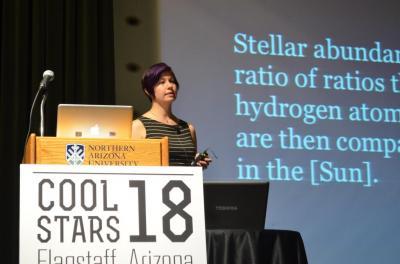TEMPE, Ariz. – An Arizona State University alumna has devised the largest catalog ever produced for stellar compositions. Called the Hypatia Catalog, after one of the first female astronomers who lived ~350 AD in Alexandria, the work is critical to understanding the properties of stars, how they form, and possible connections with orbiting planets. And what she found from her work is that the compositions of nearby stars aren't as uniform as once thought.
Since it is not possible to physically sample a star to determine its composition, astronomers study of the light from the object. This is known as spectroscopy, and it is one of the most important tools that an astronomer has for studying the universe. From it, researchers can often get information about the temperature, density, composition, and important physical processes of an astronomical object.
The digital catalog is a compilation of spectroscopic abundance data from 84 literature sources for 50 elements across 3,058 stars in the solar neighborhood, within 500 lightyears of the Sun. It essentially lists the compositions of stars, but only stars that are like the Sun – or F-, G-, or K-type (the Sun is a G-type star) – that are relatively near to the Sun.
"This catalog can hopefully be used to guide a better understanding of how the local neighborhood has evolved," explains Natalie Hinkel, who graduated from ASU in 2012 with her doctorate in astrophysics and is now a postdoctoral fellow at San Francisco State University (SFSU).
Putting together a catalog this large that is an accumulation of other people's work required a substantial amount of background research – compiling the first 50 datasets took her about six months. In total, the project took about two years. Hinkel started the project as part of her dissertation at ASU; however, a significant number of changes and revisions were done while at SFSU.
Vizier, a database where researchers can post their astronomical data, was a starting point but since not everyone posts their data online, many times Hinkel had to go to individual papers and transcribe the data by hand.
The Hypatia Catalog has a wide number of applications. The most obvious one for astronomers is looking at stars who host extrasolar planets, or exoplanets.

Natalie Hinkel gives a plenary talk at the Cool Stars 18 meeting in Flagstaff, Ariz. about her paper on the Hypatia Catalog.
(Photo Credit: Natalie Hinkel)
"Since 1997, we've known that stars with giant, Jupiter-like planets have quite a bit of iron in them. This result has been reproduced dozens of times. However, with a catalog of this magnitude, we can now study literally all of the other elements measured in stars in great detail to see if there are relationships between the presence of a planet (gaseous or terrestrial) and the element abundances," explains Hinkel.
Another example would be to look at the abundances of stars that rotate quickly versus those that rotate slowly, to see if there is a chemical relationship with their rotation speeds.
While constructing the catalog, Hinkel noticed that the stars in the solar neighborhood reveal unexpected compositions, which is discussed in the paper published in the September issue of the Astronomical Journal.
The Sun is in the disk of the galaxy, where the vast majority of the Milky Way's young stars are located. As the disk rotates, so too do the stars – both in the direction of the disk, as well as in smaller random motions.
"You can think of this like a swarm of bees: While the swarm in general moves, the bees themselves are going in all different directions. Because of this motion within the disk, the stars are considered to be well mixed – like a tossed salad. Therefore, you don't expect to see, for example, a whole tomato in your salad – or many stars that have similar abundances in close proximity to each other," explains Hinkel.
However, what Hinkel found is that the nearby 'solar salad' is comprised of lettuce at the bottom, chunks of tomato in the middle (where the middle of the galactic plane is), then lettuce again on top. In this case, the lettuce are stars that all have a high abundances of quite a few elements and the tomatoes are stars that have low abundances of those same elements.
In other words, the solar neighborhood does not appear to be a mixed salad; it's a layered salad.
"Given all of the motion in the galaxy, this was a very unexpected result. But it's also very exciting," says Hinkel.
Source: Arizona State University